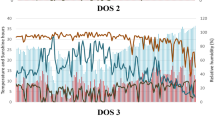Summary
An inoculation trial with S.100 and S.184 white clovers on blanket peat in Wales is described. The scores for clover vigour showed that the establishment and early development of inoculated plants were far superior to the uninoculated. Inoculation increased plant density recorded 2 months after sowing. A technique of nodule sampling and testing isolate effectiveness is described. The counts of nodules and their size distribution indicated a low indigenous rhizobial population with a high proportion of ineffective and intermediate strains. The application of lime encouraged the multiplication of effective strains and increased nodule size. The practical implications of inoculation and the use of such a survey technique is discussed.
Similar content being viewed by others
References
Bjalfve, G., Inoculation trials of leguminous plants 1914–1948. Lucerne and clover trials. Ann. Roy. Agr. Coll. Sweden16, 603–617 (1949).
Cass Smith, W. P., and Goss, D. M., A method of inoculating and lime pelleting leguminous seeds. J. Agr. W. Australia7, 119–121 (1958).
Hastings, A. and Drake, A. D., Inoculation and pelleting of clover seed. New Zealand J. Agr.101, 619–621 (1960).
Jones, D. Gareth., Variation in nodulation characteristics in S. 100 Nomark white clover (Trifolium repens L.) J. Sci Food Agr.13, 598–603 (1962).
Jones, D. Gareth., Symbiotic variation ofRhizobium trifolii with S. 100 Nomark white clover (Trifolium repens L.) J. Sci. Food Agr.14, 740–743 (1963)
Paton, D. F., Responses to seed inoculation of pasture legumes in Tasmania. Tasmania J. Agr.28, 389–398 (1957).
Poulter, A. A., Deficiency of the clover nodule organism on some Welsh soils. Welsh J. Agr.9, 145–159, (1933).
Roughley, R. J., Inoculation of legumes with nitrogen fixing bacteria. Agr. Gaz. New South Wales72, 40–44 (1961).
Soil Survey of Great Britain. Report No.14 1961, 9–10 (1962).
Thornton, H. G., The nodule bacteria and their host legumes. Some problems that they still present. Sci. Progress166, 185–204 (1954).
Toms, W. J., The use of seed inoculum for subterranean clover. J. Agr. W. Australia1, 925–926 (1960).
Van Schreven, D. A., Otzen, D., and Lindbergh, D. J., On the production of legume inoculants in a mixture of peat and soil. Anthonie van Leeuwenhoek Ned. Tijdschr. Microbiol. Parasitol.20, 33–57 (1954).
Author information
Authors and Affiliations
Rights and permissions
About this article
Cite this article
Jones, D.G., Munro, J.M.M., Hughes, R. et al. The contribution of white clover to a mixed upland sward. Plant Soil 21, 63–69 (1964). https://doi.org/10.1007/BF01373873
Received:
Issue Date:
DOI: https://doi.org/10.1007/BF01373873




